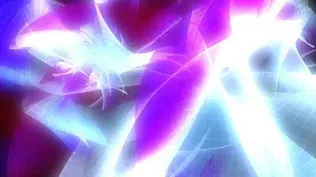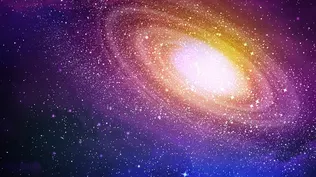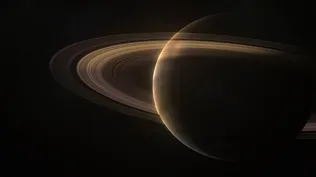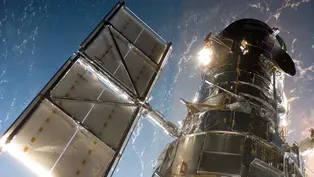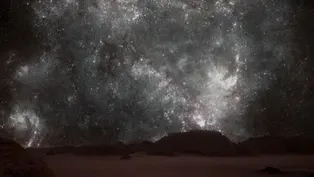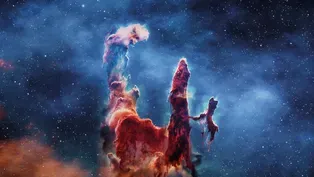

NOVA Universe Revealed: Milky Way
Season 48 Episode 16 | 53m 17sVideo has Audio Description, Closed Captions
Explore the wonders and mysteries of our galaxy—the giant city of stars we call home.
Straddling the night sky, the Milky Way reminds us of our place in the galaxy we call home. But what shaped this giant spiral of stars and what will be its destiny? NOVA travels back in time to unlock the turbulent story of our cosmic neighborhood.
See all videos with Audio DescriptionADProblems with Closed Captions? Closed Captioning Feedback
Problems with Closed Captions? Closed Captioning Feedback
Additional funding for public engagement and outreach provided by the Gordon and Betty Moore Foundation. Funding for NOVA is provided by the David H. Koch Fund for Science, the Corporation...

NOVA Universe Revealed: Milky Way
Season 48 Episode 16 | 53m 17sVideo has Audio Description, Closed Captions
Straddling the night sky, the Milky Way reminds us of our place in the galaxy we call home. But what shaped this giant spiral of stars and what will be its destiny? NOVA travels back in time to unlock the turbulent story of our cosmic neighborhood.
See all videos with Audio DescriptionADProblems with Closed Captions? Closed Captioning Feedback
How to Watch NOVA
NOVA is available to stream on pbs.org and the free PBS App, available on iPhone, Apple TV, Android TV, Android smartphones, Amazon Fire TV, Amazon Fire Tablet, Roku, Samsung Smart TV, and Vizio.
Buy Now

NOVA Labs
NOVA Labs is a free digital platform that engages teens and lifelong learners in games and interactives that foster authentic scientific exploration. Participants take part in real-world investigations by visualizing, analyzing, and playing with the same data that scientists use.Providing Support for PBS.org
Learn Moreabout PBS online sponsorshipNARRATOR: The Milky Way, our home, formed not long after the Big Bang.
One of trillions in the universe.
This is our galaxy.
♪ Billions of planets orbiting billions of stars.
We are only just beginning to understand its true place in the universe.
GERRY GILMORE: It was only a hundred years ago, people thought our Milky Way was the entire universe.
♪ PAYEL DAS: If we really want to understand where we come from and how the galaxy was formed, we can't just look in our cosmic sort of backyard.
We need to look much further afield.
NARRATOR: And when we do, we discover a universe in turmoil.
VASILY BELOKUROV: Our history is made up of multiple collisions and interactions with our neighbors.
♪ RANA EZZEDDINE: Our Milky Way is not static.
It is dynamic and it has such a rich, dynamic history.
NARRATOR: And our place in it far from secure.
♪ DAVID ROSARIO: A collision can change the structure of a galaxy, reorders the stars, so you end up with something that looks different, that behaves differently.
NARRATOR: Now we can see our galaxy's future and its inevitable end.
JEN GUPTA: The Andromeda galaxy is actually heading towards us at about 250,000 miles per hour.
GILMORE: It will be a really nice sight, actually.
You know, just watch it coming.
I mean, there's nothing you can do about it except sit back and enjoy the view.
♪ MICHELLE COLLINS: It's all coming together to tell us about how we got here and what our place in the universe really is.
♪ NARRATOR: "The Milky Way," right now, on "NOVA."
♪ ANNOUNCER: Major funding for "NOVA" is provided by the following: ♪ See me when I float like a dove ♪ ♪ The skies above are lined with trees ♪ ♪ I'm on my knees, begging please ♪ ♪ Come and take me away ♪ NARRATOR: Above us in the night sky, visible all around the world, the Milky Way wraps its arms across the sky, a band of stars like no other.
GRANT TREMBLAY: When the Milky Way is up overhead, the skies are so brilliantly bright that I swear the, the band of the Milky Way, the disk of our own galaxy, quite literally casts a shadow.
♪ COLLINS: Our Milky Way is this really incredibly beautiful place.
It's this wonderful collection of beautiful stars, gas, and dust that all kind of swirls together, almost like an abstract painting.
DAS: We've been trying to understand the band of stars that stretches across the night sky since the time of the ancient Greeks.
♪ NIA IMARA: Humans have been looking up at the night sky since the dawn of time because we want to know what's out there.
NARRATOR: Because the story of our galaxy is the story of every one of us.
GILMORE: How does it all fit together?
What are we part of?
Can we understand it?
♪ NARRATOR: The Milky Way galaxy takes its name from the dense band of stars that we see from Earth, when in fact, it's a structure that entirely surrounds us.
Every star in the sky is part of it, including our sun.
♪ SOWNAK BOSE: When looking into the night sky, you would see this band of stars stretched across it, which actually corresponds to the disk of the Milky Way.
So we actually live inside the Milky Way.
♪ EZZEDDINE: Our galaxy is a spiral galaxy.
And we can build up this picture, which we have been doing for hundreds of years so far, since the first astronomers, like Galileo, to, to kind of build up this beautiful picture of our Milky Way.
DAS: Right in the center, you have a bulge.
Then you have a pancake-like structure.
That's the disk, and that's where we are.
And then further out, you have a faint halo of stars that goes quite far beyond the disk.
COLLINS: It's this beautiful spiral structure of hundreds of billions of stars all orbiting around a supermassive black hole right at the center of the galaxy.
♪ NARRATOR: The Milky Way's complex structure has taken billions of years to evolve.
And yet, it's one of the most familiar forms in nature.
So let's start at the very center, and in the center, there is a very old bulge, contains most of the old stars.
And this is the remnants of the first stars that formed in our part of the universe.
Right at the very heart of it, there is a supermassive black hole.
That is the core of the Milky Way as we know it.
And then around that's the bulge, and then there's this big bar structure, mostly old stars, and that's what drives the spiral arms.
And so we can then say, "Where are we in all of this?"
We know pretty well where the sun is.
And hey presto, one sun, and it'll be about there, roughly halfway from the center to the outer spiral arm structures, and this is where the sun lives today.
NARRATOR: The Milky Way's elegant spirals are the signature of its dynamic history.
The challenge is how to observe it and tease out that history from our position on the inside.
COLLINS: One of the problems of trying to study the Milky Way from our position here on Earth is that it's really hard to get a sense of what the galaxy looks like overall.
So, if we really want to understand where we come from and how the galaxy was formed, we can't just look in our cosmic sort of backyard.
We need to look much further afield.
NARRATOR: Clues to how the Milky Way formed and evolved emerged in the 1990s, with the launch of the most ambitious space telescope at the time.
MAN: Five, four, three, two, one.
REPORTER: And lift-off of the space shuttle Discovery with the Hubble Space Telescope.
♪ Our window on the universe.
♪ WOMAN: Standing by for SRB separation.
Both solid rocket boosters have separated.
(crowd cheering) (people talking in background) ♪ ♪ DAS: The Hubble Space Telescope was one of the greatest feats in space missions of human history.
TREMBLAY: This 2.4-meter piece of glass, we've turned it on our universe and it has enabled untold advances.
♪ IMARA: Images from Hubble transformed astronomy-- transformed science.
♪ NARRATOR: Hubble isn't just focused on the Milky Way.
It also looks beyond, much deeper into space.
The data from Hubble is unsurpassed.
It gives us the sharpest views of galaxies and the distant universe.
DAS: Hubble's a little bit like a time machine.
It's able to pick up light from galaxies that come from very far away.
And because they've come from very far away, we're looking at them a completely different time, far back in time.
♪ NARRATOR: To look far back in time, Hubble trains its gaze on one tiny blank patch of sky for over 11 days.
What appeared was pretty incredible.
EZZEDDINE: We were able to see galaxies in this ultra-deep field that is farther away than we've ever, ever looked.
♪ DAS: So it's really given us an idea of how many galaxies there are out there and the variety of galaxies out there.
♪ TREMBLAY: It's a very hard number to estimate, but it is absolutely in the trillions.
Their morphology can be incredibly complex: big train wreck mergers or absolutely, stunningly, beautifully round grand design spirals and everything in between.
♪ There are starburst galaxies that are generating new stars at prodigious rates and there are small galaxies, which are my favorite.
We call them dwarf galaxies.
And they may be thousands of times less massive than the Milky Way, but they're actually the most common galaxy in the universe.
♪ NARRATOR: Hubble tells us there are trillions of galaxies in the universe.
And by focusing on the ones that are the farthest away, it looks deep back in time, giving us a picture of what galaxies look like in their infancy.
♪ And they started forming in an era of immense cosmic activity.
Not long after the universe began.
Before the Milky Way forms, space is filled with a vast structure known as the cosmic web.
Hydrogen and helium gas collect along the web's filaments.
But the web itself is made from something more mysterious.
It's called dark matter.
ROSARIO: Dark matter is something that has gravity but produces no light.
It surrounds us.
In fact, it dominates the mass in our own galaxy.
And yet we don't know what it is.
We, we can't touch it, we can't feel it.
COLLINS: Galaxies really need dark matter because it's kind of like the glue that binds them all together.
You can almost say it's like the seed of galaxy formation.
It creates these huge structures into which ordinary matter falls and then that matter all gets compressed and can turn into stars.
And that really is, then, what seeds galaxy formation as a whole.
NARRATOR: The first stars are born where the filaments cross and dark matter is at its densest, drawing large amounts of gas together until it collapses under its own gravity.
Causing stars to ignite.
♪ New stars in their billions are bound together by gravity, orbiting a common center.
These are the first galaxies.
Among them, the Milky Way, in its embryonic form.
♪ A whirling disk of gas and stars surrounded by an invisible halo of dark matter.
♪ Across the universe, hundreds of billions of galaxies are forming.
Some-- a few dozen-- are born very close to our own Milky Way.
♪ Over time, gravity draws these galaxies ever closer to form what we know as the local group.
EZZEDDINE: Our local group is a set of galaxies that lies in a volume of the universe that we believe is gravitationally bound together.
Meaning that these galaxies are close enough that at some point they might all combine together or collide together to form one big, large galaxy.
The galaxies within the local group can all feel one another's gravity, so they're all sort of slowly moving together with time.
♪ ♪ NARRATOR: Just three billion years after the Milky Way began, it rises in the night sky of its first planets, but with only half the stars and a more irregular structure than the mature galaxy we see today.
So how did our galaxy get its spirals?
To answer the question, a new spacecraft is built.
Gaia will look directly at the Milky Way itself.
Its designers are determined to overcome an age-old problem: how to measure the true distance between stars.
TREMBLAY: Being able to determine the distance to objects is one of the most fundamental things you need to do to understand the structure of our universe.
NARRATOR: To measure the distances accurately, Gaia's engineers must devise an orbit for the craft big enough that it can measure the same star from two points very far apart, called a parallax measurement.
Gaia will need to travel almost a million miles from Earth.
WOMAN: Attention pour la décompte finale.
Dix, neuf, huit, sept, six, cinq, quatre, trois, deux, un, top-- décollage.
I've been involved in Gaia since the very beginning of it.
It was a beautiful launch, really spectacular.
(woman speaking French) NARRATOR: The spacecraft shares the name of the ancient Greek Earth goddess, Gaia.
GILMORE: It took four minutes.
You could see the flame of the rocket and you could see the individual stages popping off.
♪ Then they got into this critical state where they had to open up the sun shields.
It was critical that this opened up and protect the payload from the sun.
And that was the do-or-die moment.
♪ NARRATOR: Gaia's mission is to map the true positions of a billion stars in our Milky Way-- nearly all of them for the first time.
BELOKUROV: Before Gaia, we just looked at the images of our galaxy.
We were missing half of the information.
GILMORE: Gaia is the first-ever precision distance measuring machine that mankind has ever had.
♪ NARRATOR: So how is it possible for Gaia to map the Milky Way so accurately from within?
♪ First, it travels to its distant vantage point called L2, a gravitational sweet spot.
It can hold here with minimal fuel use as it follows the Earth in its extensive orbit around the sun.
ROSARIO: Astronomy has always been at the forefront of technology, but the kind of technology we work with right now is absolutely amazing.
♪ NARRATOR: With just a whisper of nitrogen to help Gaia's telescopes sweep smoothly through 360 degrees four times a day, it makes over one-and-a-half million observations an hour.
♪ After four months, it has looked at the whole sky at least once.
♪ Gaia gathers data on the brightest stars across the whole sky-- stars within the disk of the galaxy, from the center to the halo and beyond.
♪ After it has traveled millions of miles in its orbit, it observes the same stars from a different vantage point.
♪ After nearly two years of almost non-stop sky-scanning, scientists can triangulate the true position of over a billion stars for the most accurate map of the galaxy ever created.
♪ The Gaia map.
BELOKUROV: The Gaia data has allowed us to see our own galaxy like never before.
EZZEDDINE: I think that Gaia opened up a really new axis of information to us that we just have never imagined it would do.
These are like having completely, you know, revolutionary cartographers make an entirely new map of our home galaxy.
NARRATOR: Finally, astronomers have their Holy Grail: the Milky Way, mapped in three dimensions.
GILMORE: This is our first-ever honest 3D picture of the Milky Way.
It's not a simulation from a computer and it is not an, an attempt at guessing the structure from approximate data.
Every one of those stars is individually measured to high precisions.
So this means that we can move ourselves around through this and see, well, what does this bit of the Milky Way actually look like?
And you decide you want to look at it from far away, and you can do that.
Or you can zoom in close and say, "I want to know "how that star cluster works.
I'll go and sit inside it."
Gaia can tell the difference between a star that's at the front of that cluster and a star that's at the back of that cluster, even though the cluster itself is 5,000 light years away.
Gaia is not only measuring where things are to delightful precision, but equally, you can see things moving.
And it's actually the moving that's the critical bit.
NARRATOR: In addition to mapping stars in three-dimensional space, Gaia captured another dimension, the result of its repeated trips around the sun: time.
This data could help us understand how our galaxy evolved.
ROSARIO: Gaia doesn't just tell us where the stars are in the sky, but also how fast they're moving across the sky and towards us, and that's an essential bit of information to understand how things change over time.
NARRATOR: Once scientists know how a star is moving, they can use Newtonian mechanics to calculate where it is going.
And using the same calculations, they can reverse the motion of the star to uncover where it has been.
This new data is revolutionizing a field of science known as galactic archaeology.
ROSARIO: Galactic archaeology is the process of identifying the history and the motion of stars so you can figure out where stars come from, how old they are, and how their motions change over time.
♪ DAS: What's been really incredible about Gaia is, if we couple it with spectra that we're observing back on Earth, we're able to date the stars and really use them as the fossils that they're supposed to be.
So this means we can work out what the fossils tell us about the evolutionary events that happened in the Milky Way's past and then date them.
So put them in chronological order.
So we combine everything together in order to get a really clear understanding of how the Milky Way came to be.
♪ NARRATOR: This new data from Gaia has helped scientists spot a pattern between the Milky Way and our neighborhood cluster of galaxies, the local group.
DAS: The important thing to know about our galactic neighbors in the local group is that nothing's actually sitting still.
Gravity means that we're all moving towards or away from each other and we're sort of playing a dance out there.
♪ IMARA: Gravity is the great cosmic attractor.
This dance of the galaxy and its neighbors have been going on for billions of years.
♪ NARRATOR: Gaia is only just now revealing the steps to this intricate intergalactic dance.
♪ BOSE: When the Gaia satellite started producing its data, and astronomers started analyzing this data, there was something rather curious.
A large sample of stars were found that seemed to be rotating in the opposite direction to the majority of stars in the Milky Way disk.
And that's really unusual.
And it was really surprising.
TREMBLAY: So that means that not all of the stars that make up our galaxy, the Milky Way, were actually born here.
COLLINS: They probably came from a different galaxy altogether.
So they're almost these alien stars that have been brought in.
NARRATOR: Gaia's data led scientists to make an astonishing discovery.
ROSARIO: So the most mind-blowing thing is that those stars are the remnants of a humongous collision, and they actually come from another galaxy.
♪ NARRATOR: If we could travel back in time ten billion years and land on one of the earliest planets within our Milky Way, we'd see something spectacular in the night sky.
♪ Billions of stars coming into view heading towards us.
♪ The Milky Way is about to collide with another galaxy from our local group.
♪ Called Gaia-Enceladus.
♪ ♪ A quarter of the size of our galaxy, Gaia-Enceladus is drawn into the Milky Way, bringing disorder to its flat disk.
When you look at a galaxy merger, it looks like an incredibly violent process, but it's actually something that's incredibly elegant, and that is because galaxies are, ultimately, mostly empty space.
And so when galaxies collide or crash together, they pass through one another like ghosts.
The chance for a star-star collision in a galaxy merger is actually exquisitely low.
BOSE: It's really quite a beautiful process, because the way in which the mutual gravity of these two galaxies actually interact with one another causes one to start sort of spiraling around.
Once it, you know, plunges in, it spirals around it, and then comes back and returns, so it's kind of like, you know, two objects in a sort of celestial ballet around one another.
ROSARIO: A collision can change the structure of a galaxy, reorders the stars in the galaxy, gives them new orbits, moves the gas into different places.
And so you end up with something that looks different, that behaves differently.
♪ NARRATOR: The invisible driver of all these interactions is the same stuff that formed the galaxies in the first place: dark matter.
♪ ROSARIO: Because it accounts for most of the gravity in the galaxy, it is dark matter that determines how violent the collision is, how rapidly and with what intensity galaxies come together when they collide.
In many ways, it determines how galaxies end up after a collision.
♪ NARRATOR: Just a few billion years after the Milky Way formed, already much more massive than Gaia-Enceladus... ...the Milky Way's gravity overwhelms its neighbor.
Absorbing it entirely.
♪ The Milky Way is bigger by a billion stars.
♪ ROSARIO: For the first time ever, we have seen how our Milky Way has grown bigger.
COLLINS: What we've learnt from this collision is really about how much richer our galaxy grew, but it doesn't actually tell us about us yet.
NARRATOR: To find out how our solar system got here, scientists have been tracing the history of another unusual group of stars.
♪ They loop around our galactic disk in a spectacular trail called the Sagittarius Stream.
COLLINS: So the Sagittarius Stream is really interesting because it might actually help us understand where we came from.
BOSE: It is what's known as a tidal stream, which is a stream of stars that have been stretched across the night sky due to the gravity of the Milky Way.
EZZEDDINE: The Sagittarius Stream is so big, it goes all the way up and even all the way down, so we can just carry the Milky Way from its handle.
It's really, really large stream.
NARRATOR: The trail of stars we see today is named after the galaxy that they used to belong to, Sagittarius Dwarf.
GILMORE: The Sagittarius galaxy was discovered by a student and myself in the '90s.
Most of the Sagittarius galaxy is actually spread out into two streams, one in the front and out the back, like giant comet tails wrapping around the entire sky, going out for maybe 100,000 light years away.
♪ We could see these, but it wasn't possible to understand how they got there.
Now, with Gaia, we have motions of these stars, so we can see what direction they're moving in, which ones are going fast, which ones are going slow.
For the first time ever, it's been possible to say, "Ah, this is what happened!"
BOSE: The Sagittarius Stream is essentially the tidal debris that has been left over when a dwarf galaxy, the Sagittarius Dwarf, actually plunged into the Milky Way.
NARRATOR: By studying the stream of stars, scientists have uncovered the story of a much more recent galactic collision.
This time, with a much smaller galaxy.
GILMORE: When the Sagittarius galaxy orbited into the Milky Way, it came, foolishly, rather far in.
♪ NARRATOR: As it dives towards the Milky Way, the dwarf galaxy begins to have its stars pulled off.
GILMORE: When it goes through the disk, it punches a hole in the disk, and the stars get put in particular patterns.
And it's got stretched into these two great long streams.
♪ NARRATOR: The much smaller galaxy encroaches upon the Milky Way, just like Gaia-Enceladus did, but the timing is intriguing, because this collision happens just before the birth of our own solar system.
TREMBLAY: One of the most important consequences of galaxy mergers, like the destruction of the Sagittarius Dwarf galaxy by the Milky Way, is a new, fresh injection of gas into the galaxy, right?
And it is gas, particularly cold gas, that is the fuel from which all stars are born.
DAS: For star formation to occur, basically, the colder, the better.
♪ NARRATOR: The most important gas that the collisions bring is made of one of the oldest and most ubiquitous elements in the universe.
(birds chirping) (radio static buzzing) So what I'm listening to here is the lifeblood of our galaxy, hydrogen.
We can detect it with our radio telescopes, like in this case, pointing right at the Milky Way.
Hydrogen is the most common element in the universe, and it's in our own galaxy.
We don't see gas with our eyes, and therefore we are not used to the idea of there being plenty of gas in the Milky Way.
But if you use a radio telescope, you can see it.
You can look at the radiation coming from that gas, and that's exactly what we're doing right now.
This gas is connected to stars deeply-- it's what stars form from.
If this gas wasn't there, stars would never have formed.
NARRATOR: Hydrogen was created shortly after the birth of the universe, and it has always been spread throughout the Milky Way.
But not evenly.
It clumps together in dense clouds that, in this iconic image, extend up to 30 trillion miles.
Scientists call them stellar nurseries, where temperatures are low enough for gas to condense.
IMARA: Stellar nurseries are some of the largest, coldest, and certainly among the darkest regions within any galaxy.
♪ If you were to fly through a stellar nursery, it would be extremely cold, and it's an extremely turbulent and chaotic place, pervaded by magnetic fields, and, and charged particles streaming throughout.
♪ It might be glowing a little bit, and as you approach closer and closer, you would realize that it's actually heating up a bit.
It's, it's actually becoming warmer.
You would perhaps surmise that this is where a new group of stars is being born.
♪ COLLINS: Hydrogen can be thought of as the lifeblood of galaxies, because it's the first building block of stars.
In the center of a star, it's fusing hydrogen together all the time to produce helium.
And that gives off energy, which allows the stars to light up.
♪ NARRATOR: When the Sagittarius Dwarf galaxy collides with our Milky Way, it brings more hydrogen to these clouds, triggering a new era of star birth.
♪ BOSE: When galaxies interact with one another and they collide with one another, what typically happens is that you actually get a big burst of star formation occurring.
And that's primarily because you are essentially bringing in a new source of star-forming fuel into the Milky Way.
♪ NARRATOR: This era coincides with the birth of our own sun, 4.6 billion years ago.
♪ DAS: The jury's still out, but we think that the sun could have formed in that first enhancement in star formation.
♪ EZZEDDINE: The timing of the collision between the Milky Way galaxy and the Sagittarius Dwarf galaxy coincides with a peak in star formation that we see happen in our Milky Way.
♪ And we know that the age of the gas in which our solar system was formed lies very close to this spike in star formation.
♪ TREMBLAY: It is certainly possible, right?
That our own solar system is anchored around a star that was born from gas that did not originate in our home galaxy-- it was taken, it was pulled, or consumed by the Milky Way when it ripped apart a satellite galaxy, maybe even the Sagittarius Dwarf.
NARRATOR: For a small galaxy, Sagittarius Dwarf has had a big impact, and not just by triggering star birth.
It plunges back and forth through the Milky Way as the galaxies become enmeshed, which likely contributed to the formation of the spiral arms.
But its influence is fast fading.
BOSE: The question as to whether the Sagittarius Dwarf galaxy is still around kind of depends on what you kind of end up thinking of as being a galaxy, after a certain point.
It is really a galaxy that is in the process of being totally disrupted.
And one day it will end up merging with the center of our galaxy.
So in some sense, it's only the sort of memory of the galaxy that is left behind.
♪ NARRATOR: When we look up at the night sky, it's easy to think of the Milky Way as static.
♪ But we now know it's evolved through a turbulent history of collisions and mergers.
EZZEDDINE: I think that Gaia opened up this whole new vision for us.
Our Milky Way is not static.
It is dynamic and it has such a rich, dynamic history.
NARRATOR: But none of it is random.
♪ The force that causes galaxies to form, merge, and evolve is gravity.
The thing that ultimately sculpts how those galaxies look is gravity.
♪ It's not the collisions.
It's the stars within those galaxies tugging on one another.
And it's the underlying dark matter halos of those galaxies merging together.
♪ COLLINS: So we're actually at a really exciting time now in astronomy.
Because we can tell the story not only of how our galaxy came to be, and how everything led up to now, but we can also start to peer into the future and see what's in store, what's yet to come for the evolution of our galaxy.
♪ NARRATOR: The more we learn about the Milky Way and its dynamic history, the more incredible it seems that we ourselves, orbiting just one star among billions, have been able to figure out our galaxy's story, written in the stars.
♪ And we are now poised to map out its ultimate fate.
GUPTA: The Milky Way is no stranger to galactic collisions.
As we look around the night sky, we see evidence that our Milky Way galaxy has had these interactions with galaxies before, but what's coming next is something on an entirely different scale.
This faint smudge of light that you see right there in the center of the image, it's not some condensation on the lens or a cloud in the sky above us.
This is an entire other galaxy, a huge galaxy, two-and-a-half million light years away from us.
To put that into units that humans can try to understand, this faint smudge of light is about 15 billion billion miles away.
♪ NARRATOR: This galaxy is called Andromeda.
♪ And is set to play a defining role in our galaxy's future.
The Hubble Space Telescope has taken extraordinary images of Andromeda.
♪ Compared to the disk of the Milky Way, Andromeda seems tiny, when in fact, it's anything but.
♪ It's our largest neighbor in the local group.
With the same spiral structure and the same long history of feeding on smaller galaxies.
♪ GUPTA: This image right here is actually ridiculous when you think about it.
It's an observation of part of the Andromeda galaxy taken with the Hubble Space Telescope, and the level of detail here is incredible.
This image contains about 100 million stars that we can see in another galaxy.
It's just mind-blowing.
When we look at it, we start to be able to understand its structure.
And what strikes me immediately is that it's kind of familiar.
If you zoom in on the spiral arm, it's exactly the same as what we see when we look into our own Milky Way.
And when we look at the Andromeda galaxy, we see this history, we see that it's been cannibalizing these satellite galaxies in a similar way to the Milky Way, growing into this beast, this giant that's a match for our own galaxy.
♪ COLLINS: We now have many beautiful images of Andromeda.
We've studied it with a huge range of telescopes, and in many ways, you know, it's a lot like the Milky Way, this beautiful spiral galaxy.
So you might think that they're, you know, going to be very similar galaxies with a very similar history.
But what we've learnt through studying Andromeda over time is that actually, they're not quite the same.
♪ NARRATOR: In fact, Andromeda is 50% bigger than the Milky Way.
And that's not all.
GUPTA: The Andromeda galaxy is actually heading towards us at about 250,000 miles per hour.
In about four-and-a-half billion years' time, that faint smudge of light we saw in the sky will collide with the Milky Way galaxy, changing our galaxy forever.
♪ NARRATOR: The Milky Way as we know it today is not eternal.
And Earth will witness the final act.
♪ Two galaxies in a single sky, gradually, but inevitably, merging into one.
EZZEDDINE: There is absolute evidence that Andromeda is going to collide with the Milky Way one day, because they are pulling each other closer and closer over time, and one day, they're just gonna come so close that they will collide.
♪ ROSARIO: Andromeda and the Milky Way, when they come together, sparks fly.
COLLINS: It's going to be an incredible time.
If we were able to view this collision happening, it would be amazing to watch the night sky change over time.
♪ GILMORE: It'd be a really nice sight, actually.
You know, just watch it coming.
I mean, there's nothing you can do about it except sit back and enjoy the view.
♪ COLLINS: We'll end up smashing these two galaxies together.
♪ There may be a huge burst of star formation initially, which will sort of light up the night sky with fireworks.
♪ And then over time, that will sort of burn off all the remaining gas we have in those two galaxies.
♪ NARRATOR: But unlike in previous collisions, this time, our galaxy is the smaller of the two.
♪ Andromeda and the Milky Way pull at each other's spiral arms... Scattering stars... Until no trace of the original structures remain.
♪ Two spiral galaxies, merged into one colossal mass of stars.
TREMBLAY: Watching the motion of galaxies is like looking at a really, really exquisite ballet in really, really slow motion.
When that dance is finally complete, the structure of the Milky Way will be forever altered.
COLLINS: While this collision will extinguish the Milky Way and Andromeda as we know them, it will also create a whole host of new stars, and around those new stars, there'll be new planets, and maybe another generation of people asking the same questions that we're asking now.
Where have they come from?
What's their place in the galaxy?
And what's going to happen in their future?
ROSARIO: We will not be able to see the beautiful galaxy that we see right now, but the universe will carry on.
♪ NARRATOR: As we look even deeper into the future, all of the galaxies in our local group will eventually merge into one enormous entity.
Floating in isolation.
♪ As the universe expands, the distance between all the galactic groups will increase and the other galaxies will simply disappear from view.
♪ COLLINS: Knowing that we can sort of look into the future many billions of years and understand what will happen to our galaxies is mind-blowing.
♪ NARRATOR: And all of this we have determined by looking up at the skies from one tiny, unremarkable outpost in the Milky Way.
BOSE: Even though we as humans have such an insignificant role in the grand scheme of things, there is so much about the vastness of space that we can understand just from our unique perspective here on Earth.
♪ TREMBLAY: Earth is a tiny little rock in a really indescribably vast cosmic ocean, right?
We are just a tiny little planet spinning in the void.
NARRATOR: But the story of our night sky is far from being complete.
And there is so much more to discover.
ROSARIO: Is there life in the universe?
And has there been life in the universe from the very beginning?
♪ EZZEDDINE: What is dark matter?
What is dark energy?
How does it affect our universe?
Particularly, how does it affect our Milky Way and even our own solar system?
♪ IMARA: We want to know where we come from.
We want to understand our origins and our destiny.
And also, we just love a good story.
We love mystery.
And the story of the universe is the greatest story of all.
♪ ♪ ANNOUNCER: To order the five-part "NOVA: Universe Revealed" on DVD, visit ShopPBS or call 1-800-PLAY-PBS.
Also available with PBS Passport and on Amazon Prime Video.
♪ ♪
Gaze at Galaxies with NASA's Hubble Space Telescope
Video has Closed Captions
Clip: S48 Ep16 | 2m 44s | The Hubble Space Telescope has revolutionized our understanding of the universe. (2m 44s)
The Milky Way and Andromeda Galaxies will Someday Collide
Video has Closed Captions
Clip: S48 Ep16 | 2m 56s | The Milky Way as we know it today is not eternal. (2m 56s)
NOVA Universe Revealed: Milky Way Preview
Video has Closed Captions
Preview: S48 Ep16 | 30s | Explore the wonders and mysteries of our galaxy—the giant city of stars we call home. (30s)
Providing Support for PBS.org
Learn Moreabout PBS online sponsorshipSupport for PBS provided by:
Additional funding for public engagement and outreach provided by the Gordon and Betty Moore Foundation. Funding for NOVA is provided by the David H. Koch Fund for Science, the Corporation...

